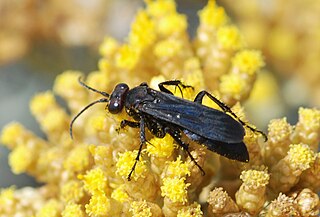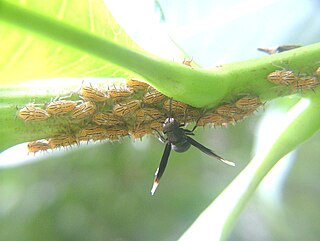
Wasps in the family Pompilidae are commonly called spider wasps, spider-hunting wasps, or pompilid wasps. The family is cosmopolitan, with some 5,000 species in six subfamilies. Nearly all species are solitary, and most capture and paralyze prey, though members of the subfamily Ceropalinae are kleptoparasites of other pompilids, or ectoparasitoids of living spiders.

The Pompilinae are a subfamily of the spider wasp family, Pompilidae, the species of which lay their eggs on the paralyzed bodies of their prey.

Anoplius is a genus of spider wasps in the family Pompilidae, called the blue-black spider wasps. It is one of two genera within the tribe Anopliini of subfamily Pompilinae.

The Pepsinae are a subfamily of the spider wasp family, Pompilidae, including the two genera of large tarantula hawks, as well as many genera of smaller species.

Cryptocheilus is a genus of spider wasps of the subfamily Pepsinae, they are found in the world's warmer regions. They vary in size from medium to large and are often strikingly coloured. The females construct multicellular nests in cavities, once built each cell is stocked with a spider, captured by the female. They are found in open habitats such as heaths, meadows and forest edges.
The Ctenocerinae are a subfamily of spider wasps, Pompilidae, which contains a small number of genera, two in the Neotropics, four in Australia and the remainder in Africa. Ctenocerine wasps have evidently evolved from a common ancestor with the Pepsinae, but are specialized for preying upon trap-door spiders (Ctenizidae).
Epipompilus is a genus of spider wasps in the subfamily Pepsinae, part of the widespread family Pompilidae. Representatives of Epipompilus can be found in Australasia and North and South America. This distribution may indicate that Epipompilus evolved in Gondwana and is similar to other Gondwanan taxa such as the southern beech Nothofagus and Auracaria.

Aporus is a genus of spider wasps from the family Pompilidae, they specialise in hunting ground dwelling spiders in their burrows for laying eggs on.

Epipompilus insularis is a species of spider wasp which is endemic to New Zealand and it is the only species of the genus Epipompilus found in New Zealand.

Evagetes is a genus of spider wasps from the family Pompilidae. There are 72 described species, of which 58 are found in the Palaearctic region, 11 in the Nearctic region, with a few penetrating to the Afrotropical, Oriental and Neotropic regions. Evagetes wasps are kleptoparasitic on other pompilid wasps, especially the genera Arachnospila, Anoplius, Episyron and Pompilus, digging into their sealed burrows, eating the host egg and replacing it with an egg of its own. Evagetes wasps are characterised by their very short antennae. Most are species are black with the base of the antennae rufous, several Evagetes species are very metallic bluish insects.

Agenioideus is a genus of spider wasps from the subfamily Pompilinae; the genus occurs in Europe, where 21 species are recorded, eastwards to Japan, in North America, South America, and Australia.

Caliadurgus is a genus of spider wasps of the subfamily Pepsinae. These are medium-sized black spider wasps with some red. They have a catholic habitat choice and their preferred prey are spiders of the families Araneidae and Tetragnathidae. They have a Holarctic and Neotropical distribution.
Ireangelus is a genus of kleptoparasitic spider wasps from the sub-family Ceropalinae of the family Pompilidae. The genus has a pan tropical distribution, being known from Oriental, Neotropical, Australian, eastern Palearctic, and Madagascan Zoogeographic regions being best represented in the Neotropics. Irenangelus is closely related to the more widespread genus Ceropales, the two genera forming a monophyletic subfamily, Ceropalinae within the Pompilidae. This is regarded as the most basal grouping of the Pompilidae but this view is problematic because of the kleptoparasitic life history of the Ceropalines, it is now considered that they Ceropalines and other pompilids evolved from a common ectoparasitoid ancestor.

Tachypompilus is a genus of spider wasps, found in the Neotropics Nearctic, eastern Palearctic, Indomalayan and Afrotropics.
Paracyphononyx is a genus of spider wasps distributed in the tropics and warmer temperate regions; they differ from other pompilids in that they do not permanently disable the host spider but allow the spider to resume activity after the wasp has laid its egg on the spider while the wasp larva exists as koinobiont ectoparasitoid of the spider.

Poecilopompilus algidus is a species of spider wasp which is widespread in the Americas.

Pepsini is a tribe of spider wasps in the family Pompilidae.

Parachartergus is a genus of epiponine social wasps belonging to the subfamily Polistinae. Species include:

Ageniellini, known as the mud-nesting spider wasps, is a tribe of spider wasps in the subfamily Pepsinae.

Ageniella is a genus of mud-nesting spider wasps in the family Pompilidae.















